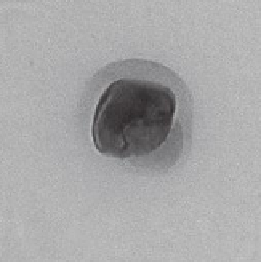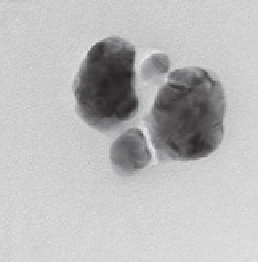Biomedical Engineering Reference
In-Depth Information
50 nm
20 nm
FIGURE 15.5
Transmission electron microscopy image of TiO
2
particles found in the
runoff of the aged facade. (Reprinted from
Environ Pollut,
156, Kaegi, R. et al., Synthetic
TiO
2
nanoparticle emission from exterior facades into the aquatic environment, 233-239.
Copyright 2008, with permission from Elsevier.)
on a small model house for one year. The Ag and Ti concentrations in the col-
lected runoff samples from the facades were measured. A high leaching of Ag was
observed during the first runoff events with a maximum Ag concentration of 145
µg/L (Figure 15.6). After 1 year the Ag concentrations were below 1 µg/L. A mass
balance calculation showed that after 1 year more than 30% of the Ag was leached
out of the facade. Also very high concentrations of Ti were measured in the initial
leachates (Figure 15.6), but the values dropped below the detection limit after a
few months.
The particles from selected runoff events were collected on transmission electron
microscopy (TEM) grids and imaged under the electron microscope. Individual Ag
nanoparticles with a size smaller than 15 nm were found to be attached to the organic
binder. Also large agglomerates of such Ag particles were observed. The authors
could not exclude the presence of single Ag NP in the runoff, but clearly the vast
majority of all nano-Ag particles was incorporated in an organic matrix. The size
of these particles, which formed a composite of Ag-NP and organic binder, varied
between a few 100 nm and a few µm. energy dispersive X-ray spectroscopy analyses
of the Ag particles showed some evidence for the formation of Ag
2
S but not for AgCl
(Figure 15.7).
The studies by Kaegi and coworkers looked at release during weathering under
ambient conditions. Koponen et al. (2009) investigated the formation of dust par-
ticles during sanding of ENM-containing paint. The particle size distribution of the
sanding dust was characterized by five size modes: three modes were under 1 μm
and two modes around 1 and 2 μm. The sander used to generate the dust was the only
source of particles smaller than 50 nm and these particles dominated the particle
number concentration. Addition of nanoparticles to the paints caused only minor
changes in the mean diameters of the particle modes compared to control paint with-
out nanoparticles. However, the number concentrations varied considerably between
the nano-paints and the nano-free reference paints. No further characterization of the
released particles was made in this study.



Search WWH ::

Custom Search